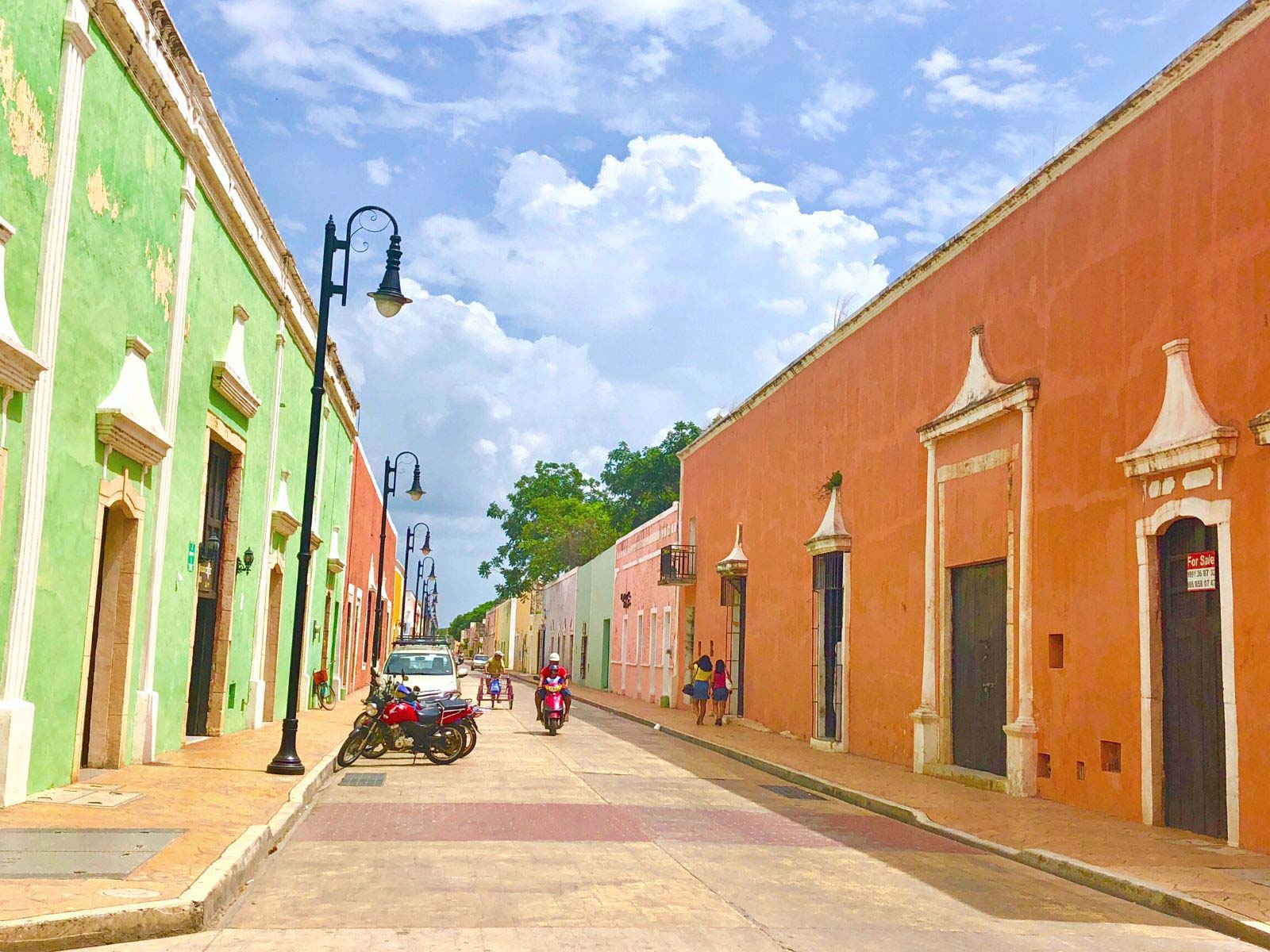Ultimate One Week Yucatan Road Trip Itinerary
Ready to start planning your Yucatan itinerary? If you’re looking for slightly off-the-beaten-path towns and sites to visit in Mexico’s Yucatan Peninsula, you’re in the right place. This seven-day Yucatan ... Continue Reading Read the original post Ultimate One...

Ready to start planning your Yucatan itinerary? If you’re looking for slightly off-the-beaten-path towns and sites to visit in Mexico’s Yucatan Peninsula, you’re in the right place. This seven-day Yucatan road trip itinerary will help you plan a unique Yucatan Peninsula trip.
The best thing about the Yucatan, located in southeastern Mexico, is that there’s no shortage of amazing places to visit, both on land and under the water. From Mayan ruins you can climb, to swimmable cenotes (natural jungle pools), there’s so much to do here that you can’t do anywhere else on Earth.
Yucatan Road Trip – All You Need to Know
This itinerary starts with all the things you need to know for a Yucatan road trip, like renting a car vs taking the bus, and how to get to the Yucatan Peninsula. After that, you’ll discover all the fun places and unique sites, which will make for an unforgettable Yucatan trip.
Where is the Yucatan Peninsula located?
The Yucatan Peninsula is located in the southeast tip of Mexico. As a peninsula, it does have water on three sides; to the south and east, there’s the bright blue Caribbean Sea, and to the north, you have the Gulf of Mexico.
There are three Mexican states that make up the Yucatan Peninsula: 1) Quintana Roo state, home to all the top destinations, like Cancun, Riviera Maya, and Tulum, 2) Yucatan state, where you’ll find colorful, colonial cities like Mérida and Valladolid, and 3) Campeche state, an off the beaten path destination.
What’s the best time to go to Yucatan?
The best months to visit Yucatan are from November to March. During these months, you get nice cool weather and low humidity. The Yucatan Peninsula has a tropical climate, so expect year-round high temperatures during the day and night, though the winter and spring seasons are much more pleasant than summer and fall.
Surrounded by water on three sides, Yucatan is susceptible to hurricanes, tropical storms and very heavy rains during the June to October rainy season. The Atlantic Hurricane Season runs from June 1 to November 30, though Yucatan weather is usually nice by the end of October.
Do I need a visa to go to Mexico?
United States, Canadian, and more European passport holders do not need a travel visa for Mexico — which is great news because if you wanted to, you can even do this Yucatan itinerary on a whim! For a list of all the countries that do require a Mexico travel visa, visit this site.
When you arrive in Mexico and go through the Customs and Immigration line, an agent will give you your 180 day (6 month) FMM tourist card. You must keep this small piece of paper on you at all times, as proof you’re in the county legally. When you leave Mexico, you must return your FMM to an Immigration officer — so don’t lose it.
Traveling to the Yucatan Peninsula
For most travelers, the easiest way to get to the Yucatan Peninsula is to fly to Cancun International Airport (code: CUN). There are smaller, regional Yucatan airports scattered throughout the area (the second largest is Merida International Airport), but it’s generally most convenient to fly to Cancun.
Yucatan Car Rentals
Cancun Airport is also the best place to get a rental car in the peninsula because it has such a large selection. For the majority of travelers, it’s safe to drive in Yucatan, with the obvious caveat that you’ll be in a foreign country, unfamiliar with its driving laws and local customs. Check car rental comparisons in the Yucatan at RentalCars.com
Driving in Mexico isn’t too dissimilar from the U.S. or Canada, but you might want to ask the agent at your cart rental for some pointers. But rest assured — Yucatan road trips are generally considered quite safe, and a very popular way to cover a lot of ground in a little time.
Prices for Mexico car rentals can vary, but you can usually rent a car for about $35 USD per day, with full coverage insurance. You do legally need Mexican insurance to drive in Mexico, and neither U.S. nor Canadian policies are valid outside of the country’s border.
Yucatan Buses
If you don’t want to rent a car, you can still do a Yucatan road trip, but know buses will eat into your travel time. Mexico has a great bus system, and you can actually travel the entire country via the ADO bus, Mexico’s largest bus company.
ADO operated a fleet of luxury-class buses, complete with comfy recliner seats, air conditioning, electrical outlets at all the seats, and restrooms on board. Ticket prices will depend on your trip route, but are usually quite reasonable at about $15 USD for a two-hour trip.
Though this itinerary talks about how to drive between places via rental car, you can also do this trip with a combination of the ADO bus and taxis. (Note: There’s no Uber in Yucatan). Now that you know all the basic travel info, let’s get to this seven-day Yucatan Peninsula!
Yucatan Road Trip Itinerary: Day 1 and 2
After arriving in Cancun, get your rental car and then hit the road. While Cancun is a great place to visit, it’s more of a place to go and enjoy the beaches, all-inclusive resorts, and sites, and somewhere you’d want to dedicate a whole trip to.
From Cancun, head about two hours northwest to Chiquila, Mexico, a small pueblo where you’ll catch the 30-minute ferry to Isla Holbox Island. You’ll have to leave the car in a paid parking lot for the next two days, as there’s no cars allowed on the island. These are secure lots, and cost about $100 MXN pesos ($5 USD) per day.
Holbox Island, Mexico
Holbox (pronounced hole-bosh) is a small, laid-back island with no street lights and beaches as gorgeous as Cancun — minus the crowds. Once a sleepy fishing village, Holbox Island has gained notoriety in the last decade, but managed to retain its small-town charm.
There’s so much to do and see in Holbox, but if you’re visiting from May 15 to September 17, take the tour to swim with the whale sharks. Whale sharks are the largest fish in the sea, averaging 30 feet in length (9 m). Each year, they hang out in the warm waters of the coast for a few months, and you can take a tour to swim with them.
Whale shark tours cost about $125 USD, and each boat has a capacity of just 10 people per tour, which is a regulation the Mexican government has in place. If you want to do this, make sure to book your tour with a local operator as soon as you arrive at Holbox.
Yum Balam is a giant nature preserve on the northern end of Holbox Island and is only accessible by boat via a tour. On the Yum Balam tours, you’ll pass by several islands in the Holbox Island chain, and Yalahau Cenote, which has amazing swimming, snorkeling, and birdwatching.
You can also rent a kayak or SUP paddleboard and check out Holbox from the water. Enjoy a tranquil voyage through the protected mangroves in Holbox and be sure to stop by Isla Pasion (Passion Island) and Isla Pajaros (Bird Island).
These two islands are home to countless species of birds, including a large flock of flamingos that live in Holbox for much of the year. Some visitors will want to go out at sunrise on a SUP paddleboard tour to the islands, though you’ll want to do this with a tour guide who knows the area.
The breeze on Holbox Island makes it one of the best places for windsurfing and kiteboarding in all of Mexico. During the winter months, when the north winds blow in, the Caribbean Sea is full of windsurfers and kiteboarders, and if you want to learn how, there are kiteboarding schools in Holbox.
When night falls, make your way to Punta Coco Beach to see the bioluminescent plankton as it sparkles on the water’s surface. You can also get in the water, and as billions of microscopic phytoplankton land on your body, you’ll start to twinkle as well. (Note: You can only see the bioluminescence during the New Moon.)
Yucatan Itinerary: Days 3 and 4
Today you’ll say adios to Holbox, and take the ferry ride back to Chiquila. Retrieve your rental car from the parking lot and make the 2.5-hour drive southwest to the Valladolid pueblo magico (magic town), located in Yucatan state.
Never heard of a Mexico pueblo magico? This prestigious designation has been awarded to about 140 pueblos, or small towns in Mexico. All the towns have unique sites and noteworthy characteristics, as well as a strong tourism infrastructure with great hotels and nice restaurants.
Valladolid, Mexico
Valladolid is one of just four pueblos magicos in Yucatan state. It is among the most beautiful colonial towns in Mexico, and one of the safest. Enjoy some time strolling the streets of this colorful town, then have a nice meal at La Casona Valladolid.
For the next two nights, you’ll want to select a hotel in Centro (Downtown Valladolid), as this area has nice, reasonably-priced accommodations. Valladolid is very walkable, and not very big, so you can even park your car for the day and get around to see the sites on foot.
While in Valladolid, don’t miss the Convent of San Bernardino of Siena, a 16th Century Franciscan convent, and San Gervasio Cathedral (AKA Valladolid Cathedral) in the Zocalo (Main Square). For art lovers, head to Casa de los Venados to see the largest Mexican folk art collection in the country.
Chichen Itza & Cenote Ik-Kil
As one of the New Seven Wonders of the World, Chichen Itza Mayan Ruins is on the bucket list of nearly every Mexico traveler. This UNESCO World Heritage Site is located about 45 minutes by car from Downtown Valladolid, so head there in the morning after a nice breakfast. Check out 7 Wonders of the World – the New, The Natural, and the Ancient
This Chichen Itza/Valladolid Tour takes you to both historic sites and to the Saamal cenote where you can swim in the azure waters. It includes a buffet lunch and a guided walking tour through Valladolid and Chichen Itza.
The Chichen Itza site is quite large, so dress in your most comfy clothes and sneakers, and don’t forget to bring your water bottle, sunscreen, and a wide-brim hat. This part is optional, but with such an important site, you’ll want to also bring enough cash to pay for a knowledgeable guide to take you around.
Guides cost about $1,000 MXN pesos ($50 USD), and will usually take 6-8 people per group. However, with such a historic place, it’s worth the money to learn every little detail you can about Chichen Itza Mayan Ruins — and there is a lot to know!
After a long and likely sweaty day touring the ruins, head to the Cenote Ik-Kil for a refreshing swim. This is one of the most beautiful and most popular cenotes in the area and is located only about 10 minutes by car from Chichen Itza.
If you prefer a more uncrowded cenote, head back to Downtown Valladolid and visit Cenote Zaci. It’s about a 10-15 minute walk from downtown, and you can swim in Cenote Zaci for free as long as you order a meal from their onsite restaurant. If not, it’s just $30 MXN pesos ($2 USD).
What is a cenote? In case you weren’t sure, cenotes (pronounced sen-no-tays) are sinkholes that contain freshwater from underground rivers. There are about 6,000 in the Yucatan Peninsula of Mexico, which is the largest concentration of cenotes found anywhere on Earth. Read more Cenotes in Photos – Discover Mexico’s Extraordinary Underground Caves
Day 4: Ek-Balam Ruins and Cenote Xcanche
Some years back, the Mexican government outlawed climbing the Chichen Itza pyramids, though you can still climb them at other Mayan Ruins in the area. If you want to climb some Mayan Ruins on your trip, head to Ek-Balam, which is also much less touristy than Chichen Itza.
Located minutes by car from the Ek-Balam Ruins, Cenote Xcanche is the ideal place to swim and cool down climbing the pyramids and exploring the ancient ruins. You can do rappelling at this cenote, ride the zipline or use a Tarzan-style rope swing to enter the cenote (or just walk in).
Since no Yucatan itinerary is complete without visiting a lot of cenotes, there are some more in this general Valladolid area. These include Cenote San Lorenz Oxman, Cenote Suytun, Cenote Dzitnup, Cenote Samula, Cenote Xkeken, and Cenote Zaci in Downtown Valladolid. Check out another amazing cenote in the Yucatan: Rio Secreto Cenote – Mexico’s Magical Underground Caves
Yucatan Itinerary: Day 5 and 6
On your fifth day, bid farewell to Valladolid and drive four hours south to Bacalar, another pueblo magico (magic town). The small town of Bacalar is best known for Laguna Bacalar, the second-largest freshwater lake in Mexico. You may also like: 15 Fun Facts About Mexico
Bacalar, Mexico
Bacalar Lake is known as the “Lagoon of Seven Colors” because you can see up to seven distinct shades of blue in the water. Thanks to its bright blue-colored water, Bacalar is also sometimes called “The Maldives of Mexico,” another destination famous for its blue waters.
Whatever you call it, Laguna Bacalar is absolutely stunning, with some of the most beautiful water in Mexico. The town of Bacalar itself provides a nice mix of relaxation, unspoiled nature, water activities, and great restaurants.
You can stay in Downtown Bacalar, or right on the lake. If you can, opt for a place on the lake so you can just walk outside your room and jump right in. Downtown just isn’t as nice, though you can save some money by staying there.
Day 5: Bacalar Boat Tour & Cenote Azul
The best thing to do in Bacalar is to take a boat tour around the lake. It is a pretty massive lake, at about 25-miles (42 m) from end to end, so the best way to see as much of it as possible is by boat. You can also rent a kayak or SUP paddleboard to go around the lake, but you obviously won’t see as much of it.
There’s a standard Bacalar boat tour that will take you to all the coolest parts of the lake, like the Canal de Piratas (Pirate’s Channel). This is a shipwreck that you can jump off of into the lake. There’s also the Isla de los Pajaros (Bird Island) and some cenotes within the lake, including Cenote Esmerelda.
The most popular cenote in Bacalar is located just outside of the lake, Cenote Azul (Blue Cenote). You will have to drive, take a taxi or walk to it, but don’t miss the chance to swim in one of the deepest cenotes in the Yucatan; Cenote Azul is at about 275-feet-deep (84 m).
Day 6: Sunrise SUP & Los Rápidos
If you’re a morning person, Bacalar is well-known for its amazing sunrises, which you can see from the lake. Head out early for a SUP paddleboard yoga class, or simply enjoy a quiet paddleboard session, as the early risers usually have the whole lake to themselves.
Los Rapidos, which means The Rapids, is one of the best balnearios in Bacalar. Balnearios are beach clubs in Mexico, and though Bacalar is a lagoon, not a beach, they still use the word balneario. There are a few beach clubs around the lake, but Los Rapidos is one that shouldn’t be missed.
As the name Los Rapidos states, there are rapids here for you to swim and play in. You can also rent a kayak at Los Rapidos and explore even more of Laguna Bacalar. There are a restaurant, bathrooms, water hammocks, and swings here as well, so it’s a great place to spend a few hours.
Yucatan Itinerary: Day 7
On the seventh and final day, it’s (sadly) time to head back to Cancun so you can return the rental car and catch a flight home. The Bacalar to Cancun drive is about 4.5 hours in normal traffic, so plan accordingly. Some people will even want to book a hotel in Cancun for one night, especially if you’re on an early morning flight.
Want to squeeze a few more sites on the drive to Cancun? There are a few off-the-beaten-path Mayan Ruins you can stop at on the way. These include Muyil Ruins and Chacchoben Ruins, both located just off Chetumal-Cancun Highway 307, the road you take to Cancun.
Which things on this Yucatan itinerary caught your eye? We’d love to hear from you, so please let us know in the comments down below.
Read more about travel to the Yucatan and Mexico
23 Amazing Things to do in Mexico’s Yucatan PeninsulaBest Things to do in Playa Del Carmen, Mexico21 Amazing Things to do in CancunWhere to Stay in Cancun: Best Hotels and Areas For Every Budget25 Best Places To Visit in Mexico10 Best Things to do in Mexico City for an Epic Trip19 Best Things to do in La Paz, Mexico
 JaneWalter
JaneWalter 































